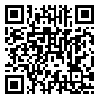
 , Zahra Jafari2
, Zahra Jafari2 
 , Maryam Noroozian3
, Maryam Noroozian3 
 , Azadeh Zendehbad4
, Azadeh Zendehbad4 
 , Hassan Haddadzadeh Niri5
, Hassan Haddadzadeh Niri5 
 , Ali Yoonessi *
, Ali Yoonessi * 
 6
6
2- Department of Basic Sciences, School of Rehabilitation Sciences, Iran University of Medical Sciences, Tehran, Iran.
3- Department of Psychiatry, School of Medicine, Tehran University of Medical Sciences, Tehran, Iran.
4- Department of Geriatric Medicine, School of Medicine, Tehran University of Medical Sciences, Tehran, Iran.
5- Department of Audiology, School of Rehabilitation Sciences, Iran University of Medical Sciences, Tehran, Iran.
6- Research Center for Cognitive and Behavioral Sciences, School of Pharmacy, Tehran University of Medical Sciences, Tehran, Iran.
Introduction: Mild Cognitive Impairment (MCI), a disorder of the elderly people, is difficult to diagnose and often progresses to Alzheimer Disease (AD). Temporal region is one of the initial areas, which gets impaired in the early stage of AD. Therefore, auditory cortical evoked potential could be a valuable neuromarker for detecting MCI and AD.
Methods: In this study, the thresholds of Auditory Steady-State Response (ASSR) to 40 Hz and 80 Hz were compared between Alzheimer Disease (AD), MCI, and control groups. A total of 42 patients (12 with AD, 15 with MCI, and 15 elderly normal controls) were tested for ASSR. Hearing thresholds at 500, 1000, and 2000 Hz in both ears with modulation rates of 40 and 80 Hz were obtained.
Results: Significant differences in normal subjects were observed in estimated ASSR thresholds with 2 modulation rates in 3 frequencies in both ears. However, the difference was significant only in 500 Hz in the MCI group, and no significant differences were observed in the AD group. In addition, significant differences were observed between the normal subjects and AD patients with regard to the estimated ASSR thresholds with 2 modulation rates and 3 frequencies in both ears. A significant difference was observed between the normal and MCI groups at 2000 Hz, too. An increase in estimated 40 Hz ASSR thresholds in patients with AD and MCI suggests neural changes in auditory cortex compared to that in normal ageing.
Conclusion: Auditory threshold estimation with low and high modulation rates by ASSR test could be a potentially helpful test for detecting cognitive impairment.
Received: 2016/10/14 | Accepted: 2016/07/1 | Published: 2017/03/16
| Rights and permissions | |
 |
This work is licensed under a Creative Commons Attribution-NonCommercial 4.0 International License. |


